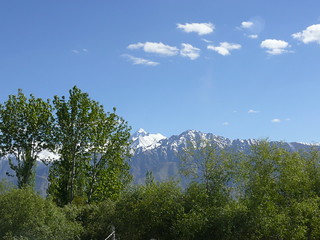If I had to sum up Ladakh in two words it would be monasteries and military. If you gave me a few more words I'd add rugged, majestic landscape. A few more? Altitude, high mountains, friendly people, prayer wheels, and contrasts. Now, you don't come to Ladakh to see the military, but you can't really avoid their presence. On the roads in convoys, bases set up all over, clever squad names like the clue finders or the mountain tamers, there is a clear military presence here. But then that shouldn't really be a surprise when you consider that the border with Pakistan and China are both quite close to this area of India. (I think we got within about fourth kilometers of the Pakistan border during our trip.) no, you come to Ladakh for the scenery. To explore an area of India that is so different from other parts. You come to visit monasteries that sit perched in mountain sides. Monasteries in remote places. Monasteries that are remarkably well kept when you wonder how they ever constructed them in the first place. Of the twelve monasteries we saw only one wasn't clinging to a hillside, that at Alchi, which was memorable for its two story clay sculptures of several different Buddhas. Sumur wasn't exactly built into a hillside like the others but its multiple layers provided its own unique view. I think my favorites where the monasteries in Hunder (you'll get more about that separately) and Diskit. Diskit (1420) is that iconic buddhist monastery, that clings to a mountainside in multilayer white stucco. Across the way is a large (ok, huge) statue of the future Buddha which in contrast to the stark landscape seems a miracle of construction. That's not the only enormous Buddha around, we saw a second golden monstrosity at Likkir (another cliff clinging monastery). He is seems to be nestled into a valley along rock walls, and was impressive in its wooden construction. Thiksay is another picturesque one, although as you wander through it it does not seem quite as old, perhaps because it is one of the wealthiest monasteries in Ladakh and so has upgraded and is very well maintained (although every monastery we visited seemed to be in great shape, even the ones that seemed more remote like Rizong). I'm not really sure what to say about all of the monasteries. They each had several temples, all different inside, with the commonality of some sort of large Buddha statue inside. I found myself enamored with the prayer wheels, which varied in material and number from site to site. Lamayuru can claim 143, Alchi 63 and Hunder just one. They are made out of tin, wood, leather, and old cans. Spinning them sends a prayer out, as the most traditional are filled with a solid paper roll of prayers. My memories of Ladakh will be filled with snapshots of monasteries, prayer wheels and smiling people.


No comments:
Post a Comment